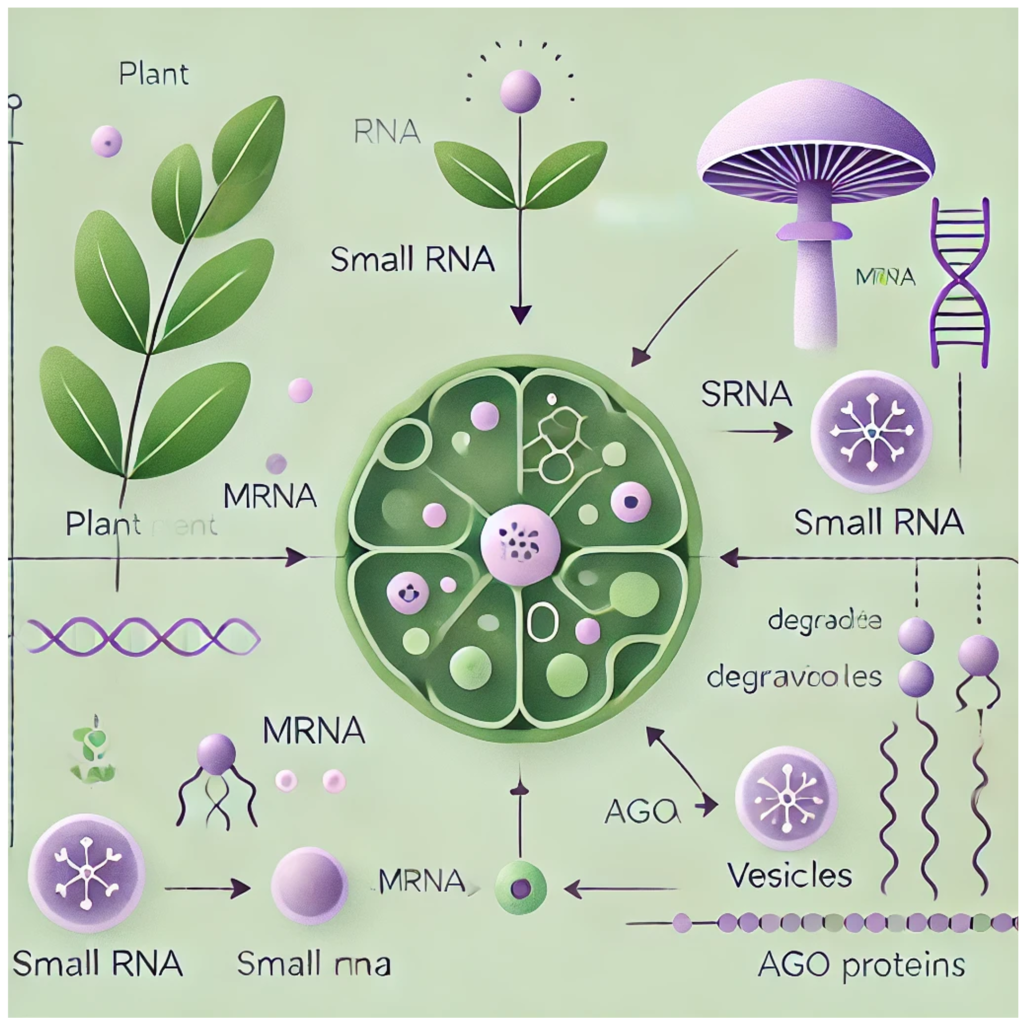
Image: Hypothetical cartoon of plant-microbe interactions. credit: OpenAI (2024), DALL-E
Plants are amazing communicators! They don’t just interact with their environment, but also exchange important messages with organisms from other kingdoms, such as bacteria, fungi, and even animals. This fascinating process is called cross-kingdom trafficking.
What is Cross-Kingdom Trafficking?
In simple terms, plants send and receive tiny packages, known as extracellular vesicles (EVs), which carry molecules like RNA, proteins, and metabolites. These packages allow plants to communicate with microbes and other organisms, helping them either fight off harmful pathogens or form beneficial partnerships, like those with fungi that assist in nutrient absorption.
The Good and the Bad: Consequences of Cross-Kingdom Trafficking
- Defending Against Pathogens: Plants use cross-kingdom trafficking to defend themselves from diseases. For example, they send out small RNAs and proteins in EVs that can disrupt the growth of harmful microbes, keeping infections at bay.
- Building Symbiotic Relationships: In some cases, plants use these EVs to establish positive relationships with helpful organisms, like fungi or bacteria that live in the soil and provide the plant with nutrients. It’s a win-win situation!
However, pathogens (the bad guys) have also evolved their own tricks. Some pathogens hijack the plant’s EV system to sneak into their cells and cause infection.
What’s New in Cross-Kingdom Trafficking Research?
Recent research from the Hailing Jin Lab at the University of California, Riverside (https://sites.google.com/a/ucr.edu/dr-hailing-jin-s-laboratory/homepage) has taken this understanding a step further. While the role of small RNAs in cross-kingdom communication was known, the team discovered that plant messenger RNAs (mRNAs) can also be delivered to pathogens through EVs (Baoye He et al., 2023). They found that these mRNAs were not only transferred to a fungus that causes grey mold disease but were also turned into proteins that helped fight the infection!
Future Potential of Cross-Kingdom Research
This exciting discovery opens up new possibilities for controlling plant diseases. Scientists are now exploring ways to develop synthetic EVs that can carry small RNAs or mRNAs specifically designed to target and stop harmful pathogens. This approach could provide a natural and effective way to protect crops from devastating diseases, reducing the need for chemical pesticides.
The world of plant communication is just beginning to reveal its secrets, and there is so much more to learn! This research brings us closer to finding sustainable solutions for global agriculture.
References
- Baoye He, Huan Wang, Guosheng Liu, Angela Chen, Alejandra Calvo, Qiang Cai, Hailing Jin*: Fungal small RNAs ride in extracellular vesicles to enter plant cells through clathrin-mediated endocytosis. Nature Communications.2023 Jul 20;14(1):4383. doi: 10.1038/s41467-023-40093-4. PMID: 37474601; PMCID: PMC10359353.
- Shumei Wang, Baoye He, Huaitong Wu, Qiang Cai, Obed Ramírez-Sánchez, Cei Abreu-Goodger, Paul R. J. Birch, and Hailing Jin*: Plant mRNAs move into a fungal pathogen via extracellular vesicles to reduce infection. Cell Host & Microbe. 2024, 32(1):93-105.e6. doi: 10.1016/j.chom.2023.11.020.
- Qiang Cai, Baoye He, Shumei Wang, Stephen Fletcher, Dongdong Niu, Neena Mitter, Paul RJ Birch and Hailing Jin*: Message in a bubble: shuttling small RNAs and proteins between cells and interacting organisms using extracellular vesicles. Annual Review of Plant Biology, 2021, doi: 10.1146/annurev-arplant-081720-010616.
- Chien Yu Huang, Po Hu, Huan Wang, Rachael Hamby and Hailing Jin*: Small RNAs – Big players in plant-microbe Interactions. Cell Host & Microbe, 2019, 26(2):173-182. doi: 10.1016/j.chom.2019.07.021.
